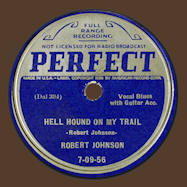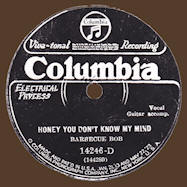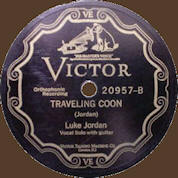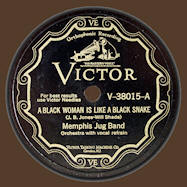
Painting © 2004 Loz
Arkle
Website
© Copyright 2000-2011 Alan White - All
Rights Reserved
Site optimised for Microsoft Internet Explorer
British Superstitions and the Blues |
||||||||||||||||||||||||||||||||||||||||||||||||||||||||||||||||||||||||||||||||||||||||||||||||||||||||||||||||||||||||||||
|
Chapter I - Conjurers and
Hoodoos Although it is generally known that witches existed, (or at least people were persecuted and murdered because they were thought to be witches) from the later medieval period onwards in the British Isles, it is not so well known (if at all) that their practices, spells and rituals would be adopted, and adapted by black slaves, and later freedmen, in the 19th. century and the twentieth in the U.S.A. Some of these rituals, etc. were to be found. in references in the recordings of the Blues, which commenced in 1920. The latter, it is generally accepted, being already over thirty years old (as a recognisable form) at the time of that first recording. Nearly 400 years ago, in Lancashire "two children and five women in the household of Nicholas Starkie, of Clayworth, were possessed in 1594. The children were the first to suffer, and a conjurer named Hartley was called in."(1). Apparently, after Hartley had been in the house for a while, the women also became possessed and it was alleged that it was the conjurer himself who was the cause of the trouble, because every time he kissed someone he breathed the Devil into them! Hole tells us "He was finally convicted of witchcraft, and hanged,"(2). Over 250 years later, the conjurer or conjure of black society in slavery times in the U.S. had more specific powers and rarely suffered the same fate as Hartley. One slave tale began "Once der was a ole man dat was a conjeror, an' his wife was a witch; an' dey had a son, an' dey larnt him to be a conjeror too; an' every night dey used to get out of deir skins an' go ride deir neighbors."(3). The tale goes on to describe how they subsequently rode their overseer, his son, their prize bull and a bull-yearling, as well a destroying their crops. This might go on all night long and in the morning the overseer and his son would be feeling tired "an' know dat de witches been ridin' 'em, but dey never find out what witches it was." (4) It was widely believed in Britain, in the 19th century, that witches rode other articles besides broomsticks; such as ladders, hurdles, and even "trundlin' on a common grindstone!"(5). Witches in the British Isles "... often had great powers over horses. Heanley once attended the death-bed of a Lincolnshire wagoner, who told him that in his youth he had insulted his landlady, Mary Atkins. She told him he would be sorry when he get to the top of Cowbank. As soon as he got there, his horses stopped, sweating and trembling, and nothing he could do would induce them to go on. He was forced at last to return and beg the woman to take the charm off', which she did after due apologies had been rendered."(6). Wagoners/waggoners were themselves supposed to have links with the supernatural. In Lincolnshire "The horsemen of this county were formerly supposed to have magical powers over their beasts, and to be able to stop them in mid-gallop by a single word."(7). Hole adds that "It is possible this had something to do with the mysterious society known as the Brotherhood of the Horseman's Word which was said to possess a charm by which any member could control the wildest horse."(8). This same charm could also be used to irritate a horse and the reputation of the waggoners spread far beyond the confines of Lincolnshire; their powers becoming more and more diversified. After describing the healing powers, in dealing with diseased cattle, of a conjuror called Meredith, a wagonner from the Welsh border country, Ron Mills adds a warning "But if this chap didn't like anybody--if he'd fell out with 'em--he could go up to their place and stand about the gate or look around there, and he could put things to 'go th' opposite way'. Perhaps he'd LOOK at a cow or summ'at and you'd find that cow dead."(9). Meredith wasn't "the only conjuror about here: there was old Enoch from Bourhrood, too".(10). In I870, a white American stated his view of black citizens "... there is a belief in a certain affinity and secret communications between themselves and wild and domestic animals. Many persons have observed a negro's way of talking to his dog or to a horse. "Aunt Bet" will say as she is milking, "Stan' aroun' now, you hussy, you. You want to git you foot in de piggin', do you?" and the cow with careful tread and stepping high will assume a more favorable position."(11). In the nineteenth century there were people "...who were regarded with deeper awe and dread: those known as 'conjurers', cunning men', 'charmers'. These men, whose reputations sometimes spread for many miles, were chiefly consulted for their powers of healing specialised diseases, discovering thieves, and count-acting witches spells"(12). But some obviously dealt in black magic as well, some were alleged to be able to raise the Devil. In the 1880's for example, Nicholas Johnson and "old Jenkyns of Trellock" (13), would make the Devil appear as a little grey old man or in more conventional form "with hoofs, horns, tail and clinking chains."(14). Another conjurer, a "long-ago vicar... " (15) from Radnorshire, had a book of spells with which he directed evil spirits, for his own secular gain.
In 1871, we learn from Rev. Francis Kilvert's diary that a conjurer
called James Jones the Jockey used a ritual which smacked very much of
hoodoo in the Deep South in the earlier part of the present century.
Jones, in an endeavor to retrieve some linen stolen from his wife, put a
live toad in a ball of clay and threw it in boiling water or on to a
fire! "... during the process of boiling or baking the toad was expected
to scratch the name of the thief on a piece of paper put into the clay
ball along with him. (15). Witches were well known to keep animal
familiars including toads and cats. The waggoners also used toads. In
East Anglia, traces of the old magic had been found, and there "horsemen
often belonged to small secret societies devoted to horse-magic or at
least shared the same ritualistic practices. Their awesome initiation
required them to go to running water at midnight, at full moon, to
perform a rite with a frog or toad bone which, ground to powder and
mixed with 'dragon's blood' (a code name for a substance attractive to
horses, unconnected with the resin of the "Dracaena draco" tree), would
give a man complete control over a horse."(16).
Even when put to its main use of bringing home a lover, the singer expresses an element of doubt in its power, or perhaps he was being realistic:
The Black Cat Bone was part of the voodoo cult that originated in Haiti, Cuba and on the African continent. In the Deer South it became 'hoodoo': But this belief was not exclusive to West Africa etc., and like other superstitions of the Blues singer "Many clearly have Anglo-Saxon origins, absorbed from the culture of the plantation-owners, and the "poor Whites"11.(24). Although Oliver only lists four examples, in passing, there were many more links with British superstitions, as will be seen in Chapter III. Hoodoo involved, as well as the popular concept of the wax doll with pins, 'hoodoo doctors', 'root men', conjures, conjure-women, and they all had potions, charms, roots, etc. which were put to purposes both for good and evil. The amount of influence from Britain has not been acknowledged, yet there existed a strong tradition in the 19th. century which has not altogether disappeared today, and quite often parallels the hoodoo cult. The 'Evil Eye' is a universal aspect of superstition and turns up quite naturally in Britain. In 1857, in Westwood Common, Shropshire, Nanny Morgan was "...an unpleasant old woman who in her younger days had been a thief and had later learned fortune-telling from gypsies; many consulted her, but she was feared rather than respected and was said to have the evil eye-- and no one durst refuse her nothing for fear she should do something at them."(25). Sometime in the 1920's, an old midwife lived in a village near Ilminster, Somerset, and "...was supposed to have the Evil Eye, though through no fault of her own, and people were afraid of offending her".(26). So her services were often 'preferred' to that of the recently appointed district nurse. In 1928, the Memphis Jug Band recorded "A Black Woman Is Like A Black Snake" referring to the caste-system within black society:
In Cheshire in 1898, "a witches power had been broken 'by having her image with nine pins stuck through it, and the nail out of a horseshoe, also a toad, all put in a bottle and burned by John, the Wizard of Hale Barns'."(28). In or around 1936, in Athens, Georgia, a black woman called Nicey Kinney told Grace McCune "Some old witch-man conjured me into marrying Jordan Jackson. What's the blessed truth, honey; a fortuneteller is done told me how it was done. I didn't want to have nothing to do with Jordan 'cause I knowed he was just a no-count old drinking man that just wanted my land and stuff. When he couldn't get me to pay him no heed hisself, he went to a old conjure man and get him to put a spell on me."(29). This would have been around 1895-1900. As late as 1970, without much-effort, some charmers were located in Devon. Working mostly with 'non-herbal cures', often with success, these charmers are purported to be the seventh son of a seventh son who is "...widely thought to have healing powers, and charmers and white witches (pow-wowers in the rural United States) continue active, especially in the West of England."(30). Blues pianist Willie Mabon recorded. a "Seventh Son" in 1955 including the claim I can heal the sick, I can raise the dead"! Blassingame tells us 'Because of their belief in fortune tellers, witches magic, signs, and conjurers, many of the slaves constructed a psychological defence against total dependence on and submission to their masters. Whatever his power the master was a puny man compared with the supernatural. Often the most powerful and significant individual on the plantation was the conjurer."(31). For similar reasons the generation that spawned the early Blues singers utilised the conjure, the hoodoo man, and the root doctor. In later years this image would be less revered by more urbanised, sophisticated singers who used the symbol, as a sexual motif. "Root Man Blues" by Walter Davis and "Root Doctor Blues" by Dr. Clayton are a couple of examples. In the postwar era, Chicago Blues singer Junior Wells would boast that he could 'out–hoodoo the hoodoo man' on his classic "Hoodoo Man" from 1959. But in the Southern states during the first decades of this century, the hoodoo man/root doctor was someone to be feared and respected in the black community, and sometimes in the white community as well! The 'doctor' working his roots would supply powerful charms such as the mojo hand (see Fig. I), High John the Conqueror and the Black Cat Bone, amongst many others. These charms covered all aspects of life; including an insurance against throwing a losing dice in the eternal crap game:
A woman with similar
powers to the conjurers of the 19th. century Britain, was Aunt Caroline
Dye or Dyer. Around 1937 an ex–slave from Alabama, related the following
part–narrative: "I know that some -people can tell things that are going
to happen. Old man Julks lived at Pumpkin Bend. He had a colt that
disappeared. He went to Aunt Caroline--that's Caroline Dye. She told him
just where the colt was and who had it and how he had to get it
back."(34). The colt was duly returned to old man Julks'. The lady in
question was immortalised in the Blues by the Memphis Jug Band; she also
cropped up on other Blues in the 1930's. II - "I've Got Your Water(s) On" The mojo, the hoodoo hand and various other charms often consisted of, amongst other things, nail–parings, pubic hair and cuttings from head–hair, menstrual cloths, and other personal items. If it was true of 'white magic' of the nineteenth century conjurers in Britain and the U.S., that "Curative charms are often associated with unpleasant substances such as urine, lice, adders, spittle or stable air,"(35), it was also true of the 'black magic' of the hoodoo men and witches, of both countries. It is the first 'unpleasant substance', urine, which seems to be the most widely used. In Shakespeare's "Comedy of Errors", Briggs says "It was suggested... that Malvolio's water should be carried to the Wise Woman, or white witch, and it was she who generally diagnosed witchcraft"(36). Much later, in Britain, when sending a person to a penal settlement in Australia, or elsewhere, was the 'answer' for many crimes; communication with that person would be a very chancey affair, so in Norfolk they devised a 'life index'. "The condemned man's relatives kept a bottle of his urine hung up in his old home. While the liquid remained clear, they knew he was well. If it became cloudy he was ill, and if it wasted away he was dead, and was duly mourned by the survivors."(37). Of course such a Potent charm as this was very popular in the world of black magic and the occult, with spells and counter-spells. To break a spell in Lancashire, "...a live cock chicken was stuck full of pins and burnt alive, after which a cake was made of oatmeal mixed with the bewitched person's urine. This was marked with the witch's name and burnt. The effect of this charm was to bring the witch to the house against her will; she would demand admittance, which had to be refused, and would either take off the spell, or would die; in either case the spell would be broken and the victim saved."(38). Baker gives a variation of this counter-spell which forms a direct link with the world of the Blues. "The heating of a bottle of the sufferer's urine, with pubic hair, pins and broken glass, would cause the tormentor such sympathetic pain as to bring her to the house to reveal herself and perhaps trade spell for counter-spell;"(39). Of course in the original spell, the 'tormentor', otherwise the witch, "...reached her victim by manipulating his hair cuttings, nail parings or urine,"(40). Some of these ingredients, as already mentioned, were used in the preparation of mojos, etc. by the root doctor, the hoodoo man/lady in the Deep South. The heating of the person's urine, relates to a phrase that often features in the Blues: "got your waters on". (see Table A).
One of the singers, Charlie Jordan, begins "Got Your Water On" with some bad news for his wayward lover:
Although the Butterbeans and Susie title might seem misplaced (unheard by me) as an ordinary domestic reference, there would appear to be more to the re-make "Been Some Changes Made" (see Table B)four years later, if indeed it is the same song, as seems likely. This husband-and-wife team were heavily into vaudeville as well as singing blues and included many humourous items in their duets/exchanges. The man, who obviously spends a lot of time away from home, with other women, comes back only to be confronted by his wife who declares "There've bin some changes made since you bin gone". Despite the punny reference to the 'waters' superstition, Susie in this scenario is not kidding, judging by her list of new lovers covering most aspects and needs of her daily life:
The wife, in this situation, would be only too prepared to work a spell on her wandering husband if he returned. By getting his 'waters on' she could be sure of his continued absence and a life of relevant luxury! Susie's lyrics would have brought a smile to the face of many a black female who heard them. But, given that Table A is not exhaustive, this does not paint the true picture of the popularity of this British superstition in the Blues. There are many Blues which include variations of the phrase "I've got your waters on" which might not be apparent in their title. (see Table B).
A young singer, still in her twenty-first year, from South Carolina, describes how she attempts to get her revenge on her lover or 'kid man'. But a mere razor is no match for the spell he has put on her:
Hill's haunting vocal, complemented perfectly by a youthful Louis Armstrong, already a supremo, on his cornet. Around eighteen months later, a 12-string guitarist working in a suburb of Atlanta selling spare-ribs, 'cooked while-u-wait', addresses his audience with obvious knowledge of their familiarity with this spell:
while the slightly risque 'Tickle Britches' declares:
The singers are saying their woman can go and enjoy herself but don't overstep the mark as they remind her of the spell on her. A guitarist from Alabama, Sonny Scott, relates how his woman left him with "...a note on my table, sayin, 'Papa, I got your waters on"(48). While in 1936, Lil Johnson is threatening in both "New Shave 'Em Dry" and "I'll Take You To The Cleaners". On the latter, she makes it very clear that with the spell she has on her man, she's running the show:
All the
examples of Blues quoted either contain a theme of an ever-present
threat to the other partner or one of them has left/is about to leave
with the spell hanging over them. The singers come from various regions,
Georgia, Alabama, South Carolina, Tennessee, Florida, etc. and feature
various styles of Blues; ranging from vaudeville-blues, hokum/good time
blues, through urban offerings to the more 'primitive' rural blues of
artists such as Barbecue Bob and Sonny Scott. One thing is abundantly
clear, that the ancient spell from the British Isles, regarding another
person's urine, was well-known to Blues singers all over the U.S.A. who
adapted the superstition to their own social environment, widely
recognised in
black society as "I've got your waters on." Notes 1.Hole C.p.165. 2.Ibid.p.166. 3.Blassingame J.W.p.128. 4.Ibid. 5.Slimpson J.p.68. 6.Hole.ibid.p.121. 7.Ibid. 8.Ibid, 9.Kightly C.p.229. 10.Ibid, 11.Jackson B.p.137. 12.Simpson.ibid.p.60. 13.Ibid. 14.Ibid. 15.Ibid.p.62. 15A.Ibid.p.64. 16.Baker.ibid.p.39. 17.Oliver P.p.125."B.F.T.M." 18.Ibid. 19.Ibid. 20.Ibid, 21.Georgia. writers Project.p.102. 22.Barefoot Bill. "Bad Boy". 23.---"-- "One More Time". 24.Oliver.ibid.n.122. 25.Simppon.ibid.p.70. 26Hole.ibid.p120. 27.Memphis Jug Band. 28.Simpson.ibid. 29.Botkin B.A.p.83. 3O.Bvker.ibid.n.171. 31.Blassingame.ibid.p.109. 32.Memphis Minnie. 33.Ibid. 34.Botkin.ibid.p.49. 35.Baker.ibid.p.170. 36.Briggs K.M.p.74. 37.Hole.ibid.p.p.46-47 38Ibid.p.p.167-168. 39.Baker.ibid.p.56. 40.Ibid. 41.The Two Charlies. 42.Butterbeans & Susie. 43.Bertha 'Chippie' Hill. 44.Barbecue Bob. 45. Martha Copeland. 46.Too Tight Henry. 47.Macon Ed & Tampa Joe. 48.Sonny Scott.
49.Lil
Johnson. Illustrations Fig.I.Oliver.P.p.103. "Story Of The Blues".
Fig.2.Moore
D.p.35. © Copyright 1992 Max
Haymes
Back
to essay overview
Website © Copyright 2000-2011 Alan White. All Rights Reserved. |
||||||||||||||||||||||||||||||||||||||||||||||||||||||||||||||||||||||||||||||||||||||||||||||||||||||||||||||||||||||||||||














